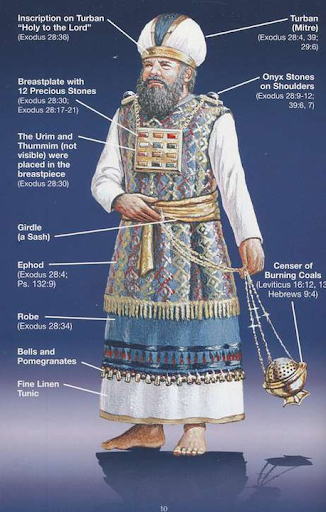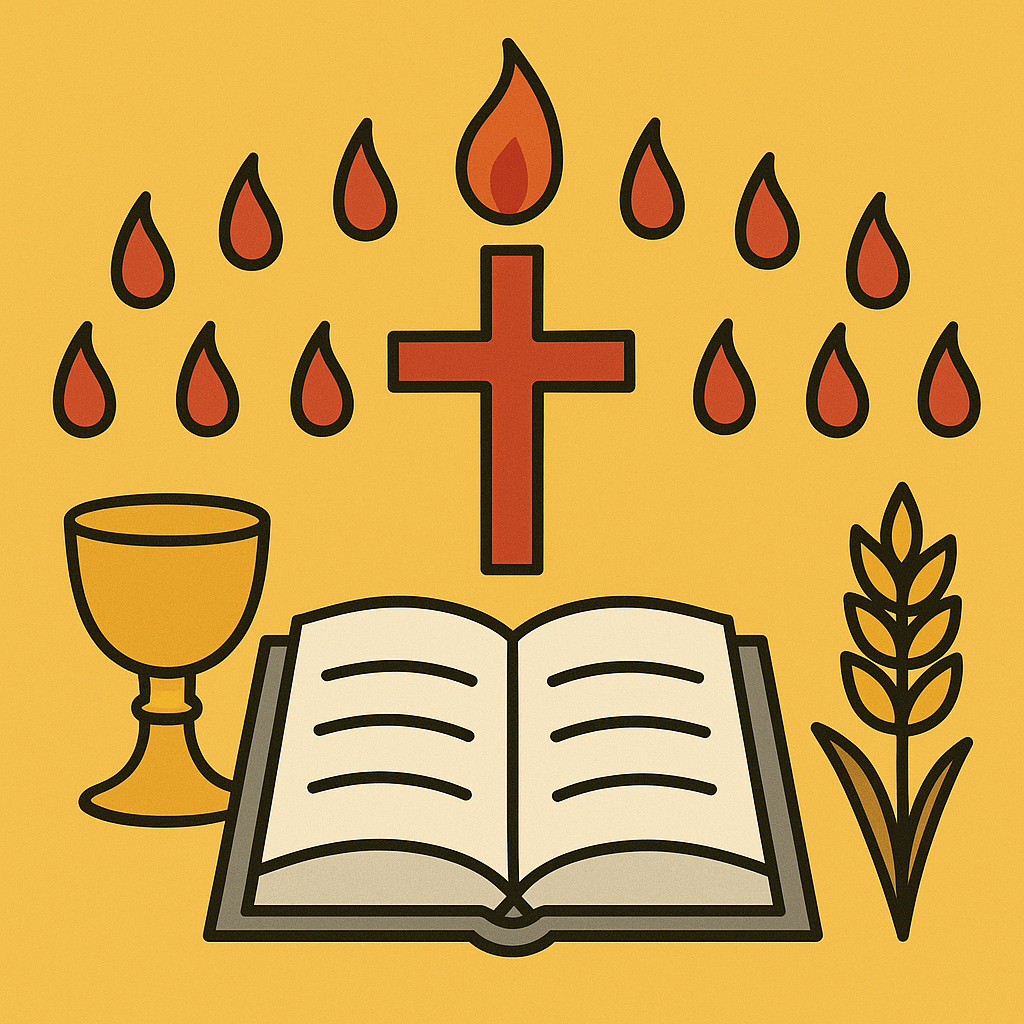Exodus 28-29
Exodus 28: The Uniform and Ordination of the High Priest
The U.S. Army says that military uniforms “contribute to building the pride and self-discipline of its soldiers.” Did you know that if you hold the rank of General, you can design your own uniform? The publicity-conscious General Douglas MacArthur wore an ornate “Philippine Field Marshal's Cap, Ray-Ban sunglasses and Missouri Meerschaum corncob pipe custom made to his specifications. As we say in the Army, “Rank has its privileges.”

For the rest of us, we had to follow Army Regulation 670-1, “Wear and Appearance of Army Uniform and Insignia,” which is 360 pages long.
After God gave Moses the instructions for the Tabernacle and told him to make it, “exactly like the pattern” He showed him. In Exodus Chapter 28 He gave instructions on the uniform of the priests. After all, would you want a high priest to wear a pair of stained, plaid Bermuda shorts, a ragged sleeveless T shirt and sandals?
Unlike the 360-page Army Regulation on uniforms, the regulation governing the priestly uniform is only two-pages long, but its purpose is similar, “To give him dignity and honor” (Exodus 28:2).
If you were to look into the priests’ footlocker or closet, here is what you would find, taken from Exodus 28:4-5: a breastplate, ephod, robe, tunic, turban and a sash. The material used to make these garments included gold and blue, purple, and scarlet yarn and fine linen.
Let’s take a look at each of these items.
Exodus 28 describes each piece of clothing from the undergarment to the headgear. The priests wore linen underwear, not wool. Boxers, not brief. They went from the waist to the knees.
Next came a tunic, a body tight garment that went from the neck to the ankles.
Over the tunic was a robe. Around the bottom of the robe were small golden bells. These weren’t for decorative purposes. They were similar to the Life Alert alarms that people wear to seek help when they fall down. The priest was allowed to go into the Holy of Holies only once a year, on the Day of Atonement. Other priests would listen for the sound of the small bells to assure them that the high priest hadn’t fallen down and couldn’t get up. One commentator said that it might also be a way of signaling to God that he is on his way to visit Him. But I think God probably already would know that.
On top of the robe, hanging like a large necklace was the breastplate. It had twelve precious stones on the front, in neat rows, each representing one of the twelve tribes of Israel. These were to remind the high priest to always intercede for all the tribes of Israel, not just his favorites. Attached to the breastplate backing was the Urim and Thummim. These were some sort of stones that were used in divining the will of God. Their exact appearance and how they were used is not known. Perhaps it was a precursor to a pair of dice or a Magic 8 ball some of us played with as kids. Do you remember them?

As a final touch there is a hat, or turban. It had a golden plate or tiara at the base with HOLY TO THE LORD engraved on it.
How do you dispose of an unserviceable priestly garment? When an American flag is too worn to be used, they are to be burnt in a respectful manner. The Talmud records the worn-out undergarments and priestly sashes were used for torch wicks in the Temple. Nothing goes to waste. Recycling goes back a long way.
Here’s an image of the high priest.

I think he looks dignified. Not only would it instill honor and respect on the part of the people, it would also encourage the priest to behave in a respectable manner. “The uniform makes the man” as they used to say.
Your sources might show some variation in the uniform, just like images of the tabernacle. Remember, it was to be made “exactly as He showed him.” He showed Moses, but he didn’t show us, he only described it to us.
Exodus Chapter 29 The Consecration of the Priests
Things are moving along nicely. We have the tabernacle and the uniforms. Now it’s time to install the priests into their office. There are two terms used to refer to this setting aside of a person or object for special use. Consecration or ordination, which is it? Ordination is the process or means by which a person is recognized as a priest, pastor, or deacon.
Consecration also means to set aside for holy use but focuses not on a person but on a thing, such as a building or land for a cemetery. We ordain people but consecrate things. Every field of study (medicine, religion, computers) has its’ own terminology and even within the community there are variations of meaning. And yes, it can be very confusing.
Exodus Chapter 29:1 “This is what you are to do to consecrate (ordain) them (the Priests).” Let’s paraphrase the instructions.
Step 1 Gather all necessary supplies and equipment (verses 1-2)
- One bull
- Two rams
- Wheat flour
- Oil
- Water
Step 2 Make bread
Step 3 Bring Aaron and sons to the Tent of Meeting and give them a bath (verse 4)
No, this was not an insult regarding their personal hygiene. It was a symbolic bath. No soap or body wash was needed. It was more like a “baptism” in a church today.
Step 4 Get Aaron dressed in his new uniform (verse 5).
Step 5 Anoint his head with oil (verse 7).
Step 6 Repeat above steps for Aarons’ sons (verse 8).
Step 7 Offer the animals for a sacrifice after laying hands on the animal to symbolically transfer the sins of man to the animal. The best parts of the animal are offered to God on the altar, as a sign of devotion to God and the rest is burnt outside the camp, symbolizing the hatred of sin. (verse 10-19).
Step 8 Place some animal blood on the right ear lobe, thumb of their right hands and big right toe. This symbolizes their hearing of the Word (lobe of ear), doing the work (thumb of hand) and walking in the way of God (toe of foot). Then sprinkle blood on the altar. Mix some of this blood with the anointing oil and sprinkle it on Aaron and his garments and on his sons (verses 19-21).
Step 9 Take parts of the ram and the bread and have Aaron wave them before the Lord as a wave offering, then take them from Aaron, put aside the breast and burn the rest on the altar. Aaron and his sons can have the breast for their lunch (verses 22-29).
Step 10 Aaron and his sons get to eat the meat and bread from the ceremony.
*NOTE: “Do for Aaron and his sons everything I have commanded you, taking SEVEN DAYS to ordain them.” (verse 35).
For those of us who only see meat at the supermarkets and have never hunted, gutted, and processed an animal for eating, these instructions might sound disgusting, more the act of a psychopathic serial killer than a religious order. But, keep in mind, these practices were like what was part of the culture in that day. Animal sacrifices, blood sprinklings, the sights, sounds and smells of what is taking place in these chapters were not foreign to the Israelites nor as disgusting to them as it would be for us. The tabernacle and services were similar enough to the practices of other religions for the Israelites to understand them, but different enough to impress upon them the uniqueness of the one true God.
The Israelites came from a society that was very visually oriented, they understood the need for visual, tangible representations of the intangible. In Egypt they were surrounded by pyramids, sphinxes, and other representations of deities. The craving for something that they could see, and touch may have led to their making of the golden calf.
Are we much different today? We still seek visual representations of the intangible. Some use ashes on Ash Wednesday, we have candles in churches, incense, etc. We take photos, and videos, we read less and watch videos more. We save mementos that have special meaning for us.
What if they went to a modern-day worship service? What would they think? “Hey, where are the animals? What? No blood sprinkling today?”
God decided to come and dwell among his people and the meeting place was in the tabernacle. Today, we don’t need a building for God to dwell in. In fact, He says in Acts 17:24, “The God who made the world and everything in it is the Lord of heaven and earth and does not live in temples built by human hands.”
God did indeed grace the Temple, and Jerusalem, and all of Israel with His presence, but, unlike the statues of pagan idols, His being is not and cannot be contained in or restricted to a single place or specific location (Isaiah 48:13, 66:1; Matthew 5:34-35). The tabernacle was a meeting place for God to speak with His people (Exodus 29:45-46).
Meanwhile, God does dwell in each of us, “Don't you know that you yourselves are God's temple and that God's Spirit dwells in your midst?" (I Cor 3:16).
“Guard the good deposit that was entrusted to you--guard it with the help of the Holy Spirit who lives in us." (2 Timothy 1:14).
Recent Articles
Share this:
Start Here...
Why Study the Bible?
Don’t many consider the Bible to be just a book of myths? Why do we read the Bible rather than the sacred literature of other religions?
How do we know that it is from God? How do we know that what we have today is an accurate translation from the original? Is the Bible complete or have there been some books that have been lost?
We should be able to answer these questions, and there are answers! So start here!
Answers to Common Bible Questions





